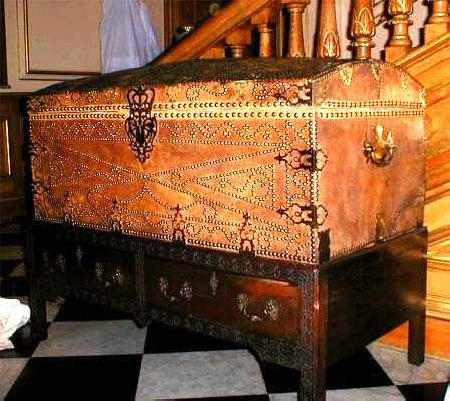Travelling trunk
Category
Furniture
Date
circa 1760 - 1770
Materials
Leather, deal or pine, brass, paper, mahogany, oak
Measurements
97 x 126 x 67 cm
Place of origin
London
Order this imageCollection
Belton House, Lincolnshire
NT 434880
Summary
A brass mounted and stud work leather travelling trunk, English, circa 1760. Raised on a mahogany stand, English, circa 1770. With a domed lid and decorated with stud work on the top and front with geometric designs in brass nails and mounted with pierced and shaped corners and angles and crown lockplate. The interior lined with a contemporary marbled paper. Raised on a mahogany stand with two drawers, the borders with blind fretwork on square section legs. The drawers linings of the stand marked to the underside with repeating measurements(?).
Full description
Travelling trunks of this form with similar decorative brass-studding originated in the seventeenth century and continued to be produced, relatively unaltered in form right through to the middle years of the 18th century. George II's coffer-maker, Edward Smith, supplied both the king and various members of the court with a large number of trunks covered with 'russia leather' (P. Macquoid and R. Edwards, The Dictionary of English Furniture, London, rev.ed., 1954, vol. II, p. 17). The trunk was probably commissioned by Sir John Cust (1718-70), lawyer, MP, and Speaker of the House of Commons (1761-1770). Also belonging to Cust are pair of leather covered trunks or caskets (NT 434800) in the library at Belton, this time covered in gilt embossed leather. All three have been later fitted with stands (circa 1770) as we can assume the trunks were commissioned circa 1761 on Cust’s appointment as Speaker. A pair of Pembroke tables (NT 434949) have identical bases and were undoubtedly made by the same workshop. All three are lined with a distinctive marbled paper which warrants further research, little is known of paper linings in furniture; however a sliding tray from Sir Rowland Winn’s Clothes Press at Nostell Priory (NT 960196) contains a very similar example and was supplied by Thomas Chippendale’s workshop in 1767. (James Weedon February 2019)
Provenance
Purchased with a grant from the National Heritage Memorial Fund (NHMF) from Edward John Peregrine Cust, 7th Baron Brownlow (b.1936) in 1984.
References
Macquoid, Percy, The dictionary of English furniture :, 1983, vol.2 pg.45
